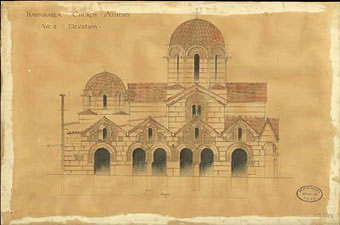
 |
 |
 |
 |
Type: Cross-in-Square
Date: middle of the 11th century
Description:
The most well known Byzantine church of Athens is situated in Ermou Street and is dated to the 11th century. It is a complex, four-columned, cross-in-square church. The exonarthex extending all over the western side of the church was added in the third quarter of the 11th century. A chapel has been incorporated in the north of the church. It is dedicated to Hagia Barbara and is dated towards the end of the Turkish domination. The name may derive from the tax kapnikon. Therefore, it may be related to the founder, á tax collector, the kapnikarius. However, it could be related to the valuable textile, kamouha. The surviving wall paintings are recent; in fact have been painted in the 20th cenury by Fotis Kontoglou and his pupils, a school mainly influenced by Byzantine tradition.
For further information see ODYSSEAS







